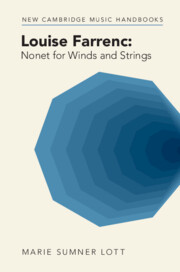Book contents
- Louise Farrenc: Nonet for Winds and Strings
- New Cambridge Music Handbooks
- Louise Farrenc: Nonet for Winds and Strings
- Copyright page
- Contents
- Figures
- Tables
- Musical Examples
- Introduction to the Life and Career of Louise Farrenc
- 1 Cultivating an Audience for Chamber Music in 1840s Paris
- 2 Dialogue and Play in the Nonet
- 3 Reception and Legacy of Farrenc’s Nonet
- Bibliography
- Index
2 - Dialogue and Play in the Nonet
Published online by Cambridge University Press: 23 October 2025
- Louise Farrenc: Nonet for Winds and Strings
- New Cambridge Music Handbooks
- Louise Farrenc: Nonet for Winds and Strings
- Copyright page
- Contents
- Figures
- Tables
- Musical Examples
- Introduction to the Life and Career of Louise Farrenc
- 1 Cultivating an Audience for Chamber Music in 1840s Paris
- 2 Dialogue and Play in the Nonet
- 3 Reception and Legacy of Farrenc’s Nonet
- Bibliography
- Index
Summary
The Nonet for Winds and Strings follows a four-movement “sonata cycle” design that had become standard in the Classical chamber music tradition by the 1840s: A sonata-form first movement in a fast tempo is followed by a slow movement and an upbeat Scherzo, then a sonata-form finale. Farrenc’s sonata forms demonstrate the influence of her teacher Anton Reicha, whose treatises provide a guide to the informed study of her works. Farrenc’s innovations include continuous development in these movements and colorful harmonic narratives that deviate from later “textbook” explanations of form. Her use of contrapuntal writing, learned variation techniques, and references to familiar pieces from the wind chamber repertoire (Septets by Beethoven and Hummel) demonstrate her compositional mastery. Throughout the Nonet, she writes expertly for the instruments and incorporates playful dialogue and brilliant-style writing for all nine players in every movement. The Nonet became her most popular work, in part, because it balances virtuosity with craftsmanship, and the fun interactions between friends within the ensemble create an atmosphere of learned play for listeners and performers alike.
Keywords
Information
- Type
- Chapter
- Information
- Louise Farrenc: Nonet for Winds and Strings , pp. 58 - 117Publisher: Cambridge University PressPrint publication year: 2025
